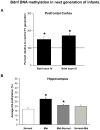Annual Research Review: Epigenetic mechanisms and environmental shaping of the brain during sensitive periods of development
- PMID: 20626526
- PMCID: PMC2965301
- DOI: 10.1111/j.1469-7610.2010.02282.x
Annual Research Review: Epigenetic mechanisms and environmental shaping of the brain during sensitive periods of development
Abstract
Experiences during early development profoundly affect development of the central nervous system (CNS) to impart either risk for or resilience to later psychopathology. Work in the developmental neuroscience field is providing compelling data that epigenetic marking of the genome may underlie aspects of this process. Experiments in rodents continue to show that experiences during sensitive periods of development influence DNA methylation patterns of several genes. These experience-induced DNA methylation patterns represent stable epigenetic modifications that alter gene transcription throughout the lifespan and promote specific behavioral outcomes. We discuss the relevance of these findings to humans, and also briefly discuss these findings in the broader contexts of cognition and psychiatric disorder. We conclude by discussing the implications of these observations for future research.
© 2010 The Authors. Journal of Child Psychology and Psychiatry. © 2010 Association for Child and Adolescent Mental Health.
Figures




References
-
- Abdolmaleky HM, Cheng KH, Russo A, Smith CL, Faraone SV, Wilcox M, Shafa R, Glatt SJ, Nguyen G, Ponte JF, Thiagalingam S, Tsuang MT. Hypermethylation of the reelin (RELN) promoter in the brain of schizophrenic patients: a preliminary report. American Journal of Medical Genetics Part B: Neuropsychiatric Genetics. 2005;134:60–66. - PubMed
-
- Barreto G, Schafer A, Marhold J, Stach D, Swaminathan SK, Handa V, Doderlein G, Maltry N, Wu W, Lyko F, Niehrs C. Gadd45a promotes epigenetic gene activation by repair-mediated DNA demethylation. Nature. 2007;445:671–675. - PubMed
-
- Berger SL. The complex language of chromatin regulation during transcription. Nature. 2007;447:407–412. - PubMed
-
- Bhattacharya SK, Ramchandani S, Cervoni N, Szyf M. A mammalian protein with specific demethylase activity for mCpG DNA. Nature. 1999;397:579–583. - PubMed
Publication types
MeSH terms
Substances
Grants and funding
LinkOut - more resources
Full Text Sources

